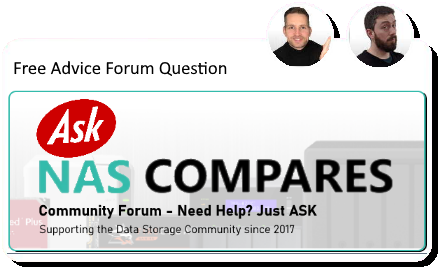07-04-2025, 01:43 PM
1. RAID Selector on the D4-320
The rear photo of the D4-320 does show a selector, but it’s not a hardware RAID controller. The D4-320 is a JBOD enclosure — it presents each drive individually to the host computer. The dial is mainly for setting which physical bay the USB host sees as “first” for boot priority. Actual RAID or spanning would have to be done in your operating system or software.
2. NAS vs. USB Enclosure
Since you’re just backing up one personal computer, a NAS isn’t necessary, but it does offer some added value:
• Independent of your PC, always-on network storage you can access from any device.
• Built-in backup apps, snapshots, remote access, and even media streaming.
• More fault tolerance if you set up RAID properly.
If you think you might benefit from those, the F4-212 is worth considering, especially at a good price. If you just want direct-attached backup with minimal fuss, the D4-320 is fine.
3. Combining Disks into One Big Volume
The D4-320 itself does not do this on its own. You can use Windows Disk Management to create a spanned or striped volume across all the drives if you’d like to see one big disk in Windows. But keep in mind: with spanning, if one disk fails, you risk losing all the data in that volume — so it’s not recommended for critical backups.
4. Managing Files Across Drives
If you don’t span the drives, they’ll just appear as separate drives in your PC. You can manually organize what gets saved where, or use backup software to automate jobs to each drive individually.
The rear photo of the D4-320 does show a selector, but it’s not a hardware RAID controller. The D4-320 is a JBOD enclosure — it presents each drive individually to the host computer. The dial is mainly for setting which physical bay the USB host sees as “first” for boot priority. Actual RAID or spanning would have to be done in your operating system or software.
2. NAS vs. USB Enclosure
Since you’re just backing up one personal computer, a NAS isn’t necessary, but it does offer some added value:
• Independent of your PC, always-on network storage you can access from any device.
• Built-in backup apps, snapshots, remote access, and even media streaming.
• More fault tolerance if you set up RAID properly.
If you think you might benefit from those, the F4-212 is worth considering, especially at a good price. If you just want direct-attached backup with minimal fuss, the D4-320 is fine.
3. Combining Disks into One Big Volume
The D4-320 itself does not do this on its own. You can use Windows Disk Management to create a spanned or striped volume across all the drives if you’d like to see one big disk in Windows. But keep in mind: with spanning, if one disk fails, you risk losing all the data in that volume — so it’s not recommended for critical backups.
4. Managing Files Across Drives
If you don’t span the drives, they’ll just appear as separate drives in your PC. You can manually organize what gets saved where, or use backup software to automate jobs to each drive individually.





